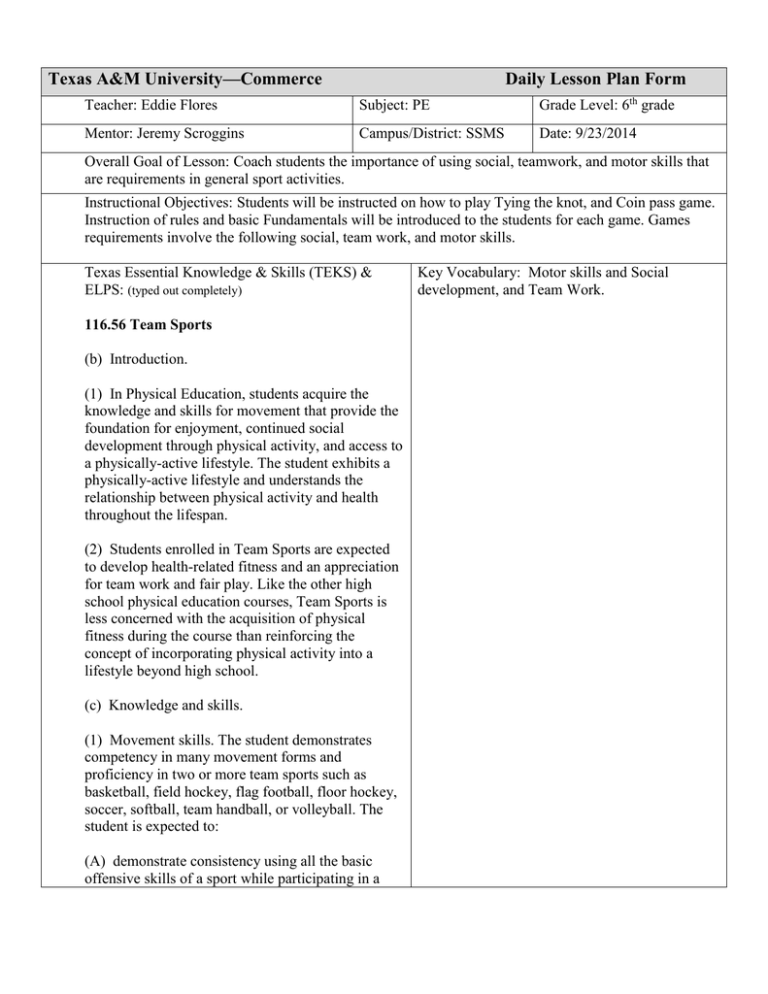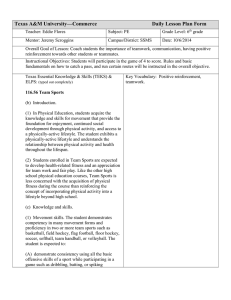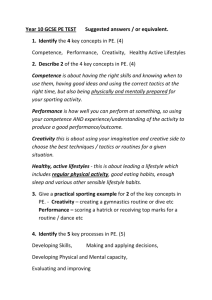File
advertisement

Texas A&M University—Commerce Daily Lesson Plan Form Teacher: Eddie Flores Subject: PE Grade Level: 6th grade Mentor: Jeremy Scroggins Campus/District: SSMS Date: 9/23/2014 Overall Goal of Lesson: Coach students the importance of using social, teamwork, and motor skills that are requirements in general sport activities. Instructional Objectives: Students will be instructed on how to play Tying the knot, and Coin pass game. Instruction of rules and basic Fundamentals will be introduced to the students for each game. Games requirements involve the following social, team work, and motor skills. Texas Essential Knowledge & Skills (TEKS) & ELPS: (typed out completely) 116.56 Team Sports (b) Introduction. (1) In Physical Education, students acquire the knowledge and skills for movement that provide the foundation for enjoyment, continued social development through physical activity, and access to a physically-active lifestyle. The student exhibits a physically-active lifestyle and understands the relationship between physical activity and health throughout the lifespan. (2) Students enrolled in Team Sports are expected to develop health-related fitness and an appreciation for team work and fair play. Like the other high school physical education courses, Team Sports is less concerned with the acquisition of physical fitness during the course than reinforcing the concept of incorporating physical activity into a lifestyle beyond high school. (c) Knowledge and skills. (1) Movement skills. The student demonstrates competency in many movement forms and proficiency in two or more team sports such as basketball, field hockey, flag football, floor hockey, soccer, softball, team handball, or volleyball. The student is expected to: (A) demonstrate consistency using all the basic offensive skills of a sport while participating in a Key Vocabulary: Motor skills and Social development, and Team Work. game such as dribbling, batting, or spiking competently in a dynamic setting; and (B) Demonstrate consistency using all the basic defensive skills of a sport while participating in a game such as guarding, trapping, blocking, fielding, tackling, or goalkeeping competently in a dynamic setting. (2) Movement skills. The student applies movement concepts and principles to the learning and development of motor skills. The student is expected to: (A) use internal and external information to modify movement during performance; (B) describe appropriate practice procedures to improve skill and strategy in an activity; (C) develop an appropriate conditioning program for the selected activity; (D) identify correctly the critical elements for successful performance within the context of the activity; and (E) Recognize that improvement is possible with appropriate practice. (3) Social development. The student understands the basic components such as strategies, protocol, and rules of structured physical activities. The student is expected to: (A) acknowledge good play from an opponent during competition; (B) accept the roles and decisions of officials; (C) demonstrate officiating techniques; and (D) Research and describe the historical development of an individual sport. Higher Order Questions: Why are social, team work and motor skills important? Could these games be played without social interaction? Student Activities: (Keep in mind the following: Scaffolding, Independent or Cooperative activities, Groupings, Reading, Writing, Listening, Hands-On/Minds-On, Connections to previous knowledge, etc) N/A Modifications/ELL Strategies Lesson can be translated in Spanish if needed. Time Allotted 5 Minutes 5 Minutes 5 Minutes 10 Minutes 5 Minutes 10 Minutes 5 Minutes Anticipatory Activity for Lesson: Students will be able to ask each other questions, and will also be able to share information in their groups. Teacher Input/Lesson Activity: Attendance Check Introduction: (Bell ringer) Introduce key words (teamwork, social, motor skills) Emphasize the importance of how these attributes are relative to general sports activities. Sports activities involved for the day will be tie the knot and Coin pass game. In addition both games will be instructed on rules of the games. The class will be divided into 4 groups; students will remain in the same group for both game activities. Physical fitness stretch Modeling: Tie the knot and Coin pass game will be modeled by the Teacher, and will show different examples of the games in regards to rules, and regulations. . Independent Practice: Tying the Knot. Groups will participate in tying the knot game. Students will be allowed to verbally communicate along with their group members to play the game. Guided Practice: Coin Pass game will have a quick pass, and catch practice before the actual game is displayed. Coin Pass game. Students will remain in groups and participate in the game. Lesson Closure: After students have participated in both games, Bell Ringer key words will be pointed out, and be examined on how much impact they had in the game activities. Assessment Methods/Strategies: Resources (supplies, equipment, software, etc.): 1. Baskets 2. Pucks (Coins) 3. Balls 4. Gym Reflection: It is essential that students understand the importance of teamwork, and social skills to further excel in group activities.






